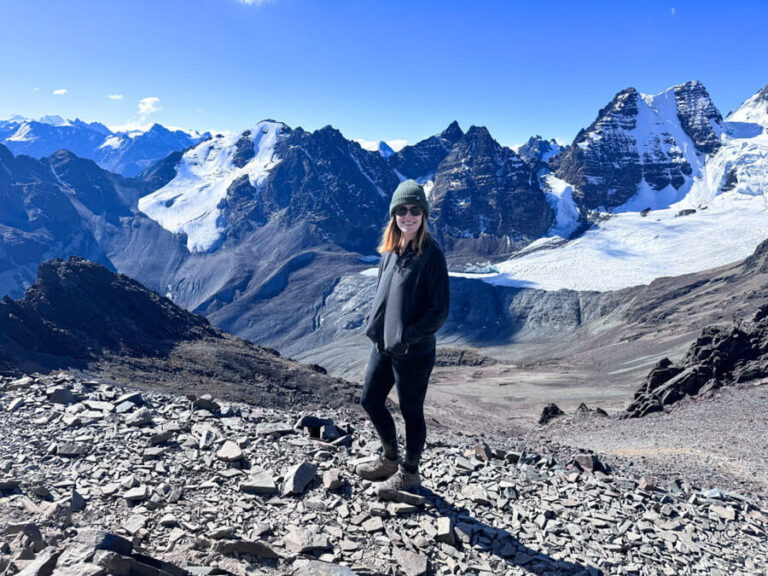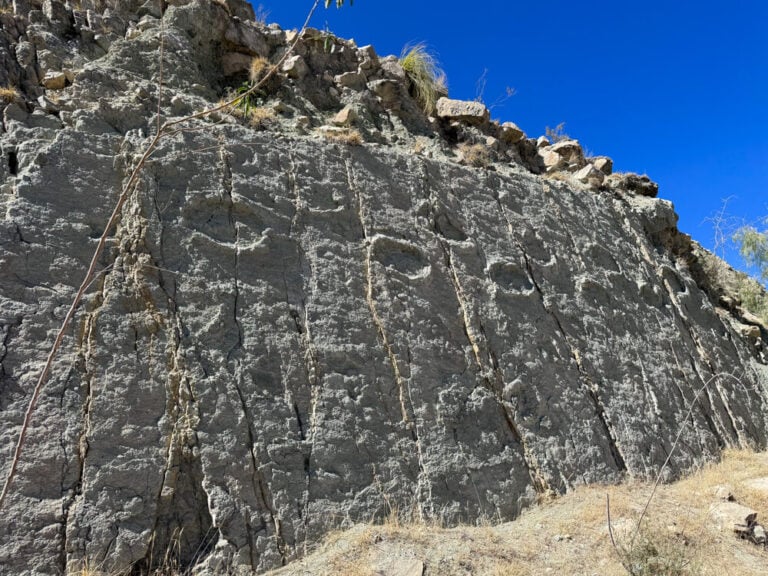10 Reasons to Visit Sucre – The White City of Bolivia

Are you wondering if Sucre is worth visiting? Well, I’m here to convince you it is. This unique city, known as ‘The White City,’ offers a fascinating insight into Bolivia’s history and showcases a completely different side of the country.
With its colonial architecture, cobblestone streets, and white buildings, Sucre is one of Bolivia’s most beautiful cities. Although I only spent a few days there, I could have stayed for weeks.
In this post, I’ve shared ten reasons to convince you that Sucre is worth visiting. I’ve also included some basic information on how to get there, where to stay, and the best things to do in Sucre. I hope you find it helpful!
A quick guide to Sucre
About the city
Once the capital city of Bolivia, Sucre is the birthplace of the country’s independence from the Spanish Empire and home to several historic landmarks. A UNESCO World Heritage Site, it’s a symbol of Bolivia’s rich history and is renowned for its beautiful colonial architecture, white buildings, and vibrant cultural heritage.
Today, Bolivia has two capital cities: Sucre, the constitutional capital, and La Paz, the administrative capital. Although Sucre no longer has the political power it once did, it remains a significant cultural and historical place.
Sucre is also one of the wealthiest cities in Bolivia. Its proximity to Potosí, the mining capital, made it a desirable place for wealthy families and Spanish royalty to settle during the colonial era. Home to one of the country’s oldest universities, the city attracts scholars from all over.
The city has an entirely different feel than anywhere else in Bolivia.

How to get to Sucre
As a major city in Bolivia, Sucre is well-connected to other parts of the country. There’s a small airport in Sucre which connects to major cities, including La Paz and Santa Cruz de La Sierra. However, for most people, taking a bus is the best option to get to Sucre.
Bolivia has a fantastic bus network connecting all the top places to visit. While the overnight buses in Bolivia don’t always have the best reputation, I found them a great way to get around the country. The main thing is to ensure you are going with a reputable company. I used BusBud to book all of my buses in Bolivia.
The most common route in Bolivia is to go from La Paz to Salar de Uyuni. If you’re keen to visit Sucre, I’d recommend going from La Paz to Sucre, then Sucre to Salar de Uyuni (or vice versa). You can also reach Sucre by bus from Tupiza, Potosi, Cochabamba and Santa Cruz de La Sierra.
The main bus station in Sucre is quite far from the city centre, where most hostels and hotels are located. Once you arrive, you’ll likely need to take a taxi (there’s a taxi stand outside the station).
How long to spend in Sucre?
You can easily see the main highlights of Sucre in a day, but I’d recommend spending at least two days there to get a real feel for the city. There’s lots to see and plenty of restaurants to try, and two days give you a nice amount of time without having to rush.
For those who prefer to travel a bit slower, Sucre is one of those places where you could easily spend weeks. It’s cheap, has great food and is filled with interesting history and things to do. Life seemed slower-paced in Sucre, and I met several nomads and backpackers who were basing themselves there for a few weeks.
It’s also an excellent place to learn Spanish (one of the best places in Latin America). So, if this is on your list, consider spending extra days in Sucre to make the most of the cheap and high-quality lessons.

Where to stay in Sucre
I’d recommend staying in the city centre of Sucre, close to the famous Plaza 25 de Mayo. It’s a great location with restaurants, bars, museums and shops. Once you’re there, you can walk just about anywhere.
If you’re on a budget, there are a few hostel options. I stayed in Villa Oropeza, the most popular hostel in Sucre. I can’t say I was overly impressed, but it’s cheap and has a lovely outdoor area. Dragonfly Guesthouse is another popular option.
If you want a bit more privacy, CasArte is a fantastic option. It’s a beautiful building and in an excellent location.
Reasons to visit Sucre
To learn about Bolivia’s history
Sucre is a fascinating place to learn more about Bolivia’s history, especially from the Spanish colonial era. Sucre is proud of its part in Bolivia’s history, and there are several museums worth visiting where you can learn more.
Casa de la Libertad (House of Liberty)
The city was one of the most important for the Spanish Empire and played a huge role in Bolivia’s fight for independence. The Declaration of Bolivia’s Independence was signed in 1825 in ‘Casa de la Libertad’ (House of Liberty). Today, the building is a museum where visitors can learn more about this key document.
Museo Nacional de Etnografía y Folklore
I visited this museum as part of a walking tour around Sucre and found it fascinating. The museum offers a deep dive into Bolivia’s indigenous cultures and houses traditional clothing, crafts, and artefacts.
The Museum of Indigenous Art
This is another great spot to learn more about the indigenous people of Bolivia. As the name suggests, it focuses on Indigenous art and has a great collection of textiles, artefacts, and even folk art. You can sometimes see women weaving traditional clothes and textiles.
Museo del Tesoro – The Treasure Museum
This interesting museum showcases a range of artefacts relating to Bolivia’s colonial past. This was another stop on my free walking tour of Sucre.
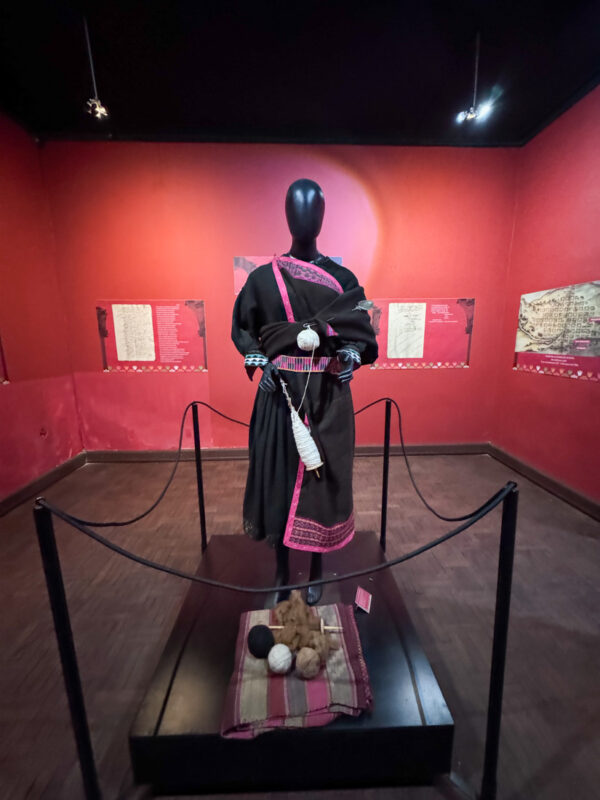

For the beautiful buildings
Sucre is known as ‘The White City’, and it quickly becomes apparent why. The city centre is filled with white buildings with red-tiled roofs, which only exaggerate the colonial feel of the city.
There’s a rumour that residents don’t have to pay property tax if they have white buildings, but one of my local tour guides in the city debunked this rumour. She explained that most of the buildings are white due to the Spanish colonial influence, and this has become part of the city’s cultural identity.
Sucre became a UNESCO World Heritage Site in 1991, and a big part of this was due to the well-preserved architecture and buildings, which are a big part of Bolivia’s history. The government and locals are proud of the city, and do their best to keep it looking the way it does.
You don’t need to travel far to experience the incredible architecture of Sucre. Most buildings and streets in the city centre have a traditional Spanish feel, with narrow cobblestone streets and white buildings with beautiful courtyards.
Some of the most famous historical landmarks include:
- The Metropolitan Cathedral
- La Recoleta Convent
- Casa de la Libertad, where the Declaration of Independence was signed
- San Francisco Church
- Guereo Mansion (this really shows off the colonial architecture)
I also loved walking around Plaza 25 de Mayo to get a real feel for the city.

To experience a traditional Bolivian market
Bolivia has some of the best markets I’ve ever experienced. Many locals rely on their local markets instead of supermarkets. These markets sell everything from fruit and vegetables to dairy, meat, electrical items and toiletries.
The main market in Sucre, El Mercado Central, is one of the best markets I visited in Bolivia. I managed to get so many cheap ingredients here, including fresh fruit and vegetables, bakery items, and even coffee. The market also has a food court where you can try cheap, local food and create your own smoothie or juice.
Whether you’re on a budget or not, visiting El Mercado Central is an absolute must while in Sucre. Just be prepared for a sensory overload and being spoiled for choice when trying food.
For the epic city views
Sucre is built in the Chuquisaca Valley, surrounded by the incredible Andes mountains. While you can enjoy views of the mountains, there are also some great viewpoints of the city itself. You’ll need to walk up some steep roads (or take a bus) to get the best views, but it’s well worth seeing the beauty of this colonial city from above.
One of the best viewpoints in Sucre is Mirador La Recoleta. It’s located in Plaza Pedro De Anzures and boasts epic views of the entire city, particularly at sunset. Another great viewpoint is at the top of the Convent of San Felipe Neri. You can walk up to the bell towers for panoramic views (when I visited in 2024, it was open on Mondays to Saturdays from 2:30 p.m. to 5:30 p.m.).
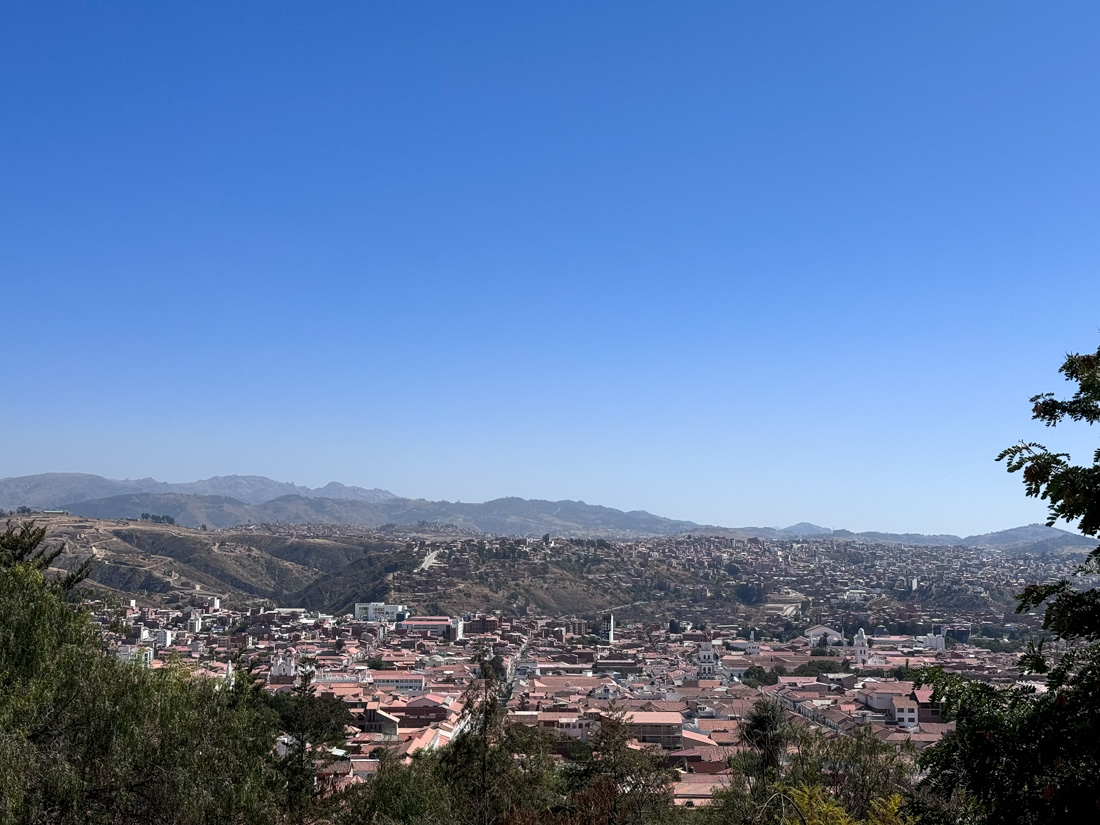
Another good spot for views is a cafe called Mirador San Miguel (next door to Casa de La Libertad). The cafe has seating over several floors, and the top floor offers fantastic views of the area.
There are real-life dinosaur footprints
One of the best things to do in Sucre is to visit Cal Orck’o, which has one of the world’s largest collections of dinosaur footprint tracks. Yes, you can see actual real-life dinosaur footprints in Sucre!
A few kilometres from the centre of Sucre is a huge limestone quarry which is home to an incredible collection of dinosaur footprints. The footprints are believed to be around 68 million years old, and you can even see footprints from a baby T-rex.
A shuttle bus (also known as the Dino Bus) takes you straight to the park, making it an easy activity while in Sucre. You need to be at the park at either 12 p.m. or 1 p.m. to enter the quarry and get close to the footprints.

There are some great hikes nearby
Sucre is a great base to explore the nearby area. One of the best hikes near Sucre is the Maragua Crater trail, which is also known as one of the best hikes in Bolivia.
Nobody knows exactly what formed this giant crater, but it’s believed to have been either a giant meteorite or formed by erosion. It’s also another great spot to see dinosaur footprints and stunning scenery.
The most popular option is to do a day trip into the crater. This involves walking along an Inca Trail from the 12th Century before taking a jeep ride to the crater.
For the more adventurous, you can do a 2-day overnight hike to explore the area more in-depth.
To try the chocolate
Sucre is one of the best places in the country to try Bolivian chocolate. The city is famous for its chocolate production, which is made from high-quality cacao beans grown in Bolivia.
Para Ti and Taboada are the two most popular places to try the Bolivian chocolate. Both have shops where you can stock up on tasty chocolate and try some samples.
There is a museum of chocolate for hardcore fans, which teaches visitors about chocolate production. I tried a hot chocolate in Sucre and it was delicious (although not quite as good as the hot chocolate I had in La Paz).
To learn Spanish
Sucre is one of the best places in Bolivia (and all of South America) to learn Spanish. The city is filled with affordable Spanish schools offering everything from single lessons to month-long courses. I met several people who were basing themselves in Sucre for a few weeks while attending Spanish school.
Bolivia also has a relatively easy style of Spanish compared to other countries such as Chile and Argentina, which are renowned for having strong accents that make it difficult for European learners. So, if you’re on a longer trip through South America, Bolivia is a good option for learning Spanish.
I also think Sucre is a good base for spending a longer period of time. It’s much less chaotic than La Paz, it’s relatively cheap, has some great food, and has a growing community of long-term nomads and backpackers.

If you want to learn Spanish while travelling in Latin America, I highly recommend heading to Sucre.
For the food and nightlife
One thing that surprised me about Sucre was the variety of food and the nightlife. It has a much more European and backpacker feel than other places I visited in Bolivia (aside from Samaipata).
The food scene is one of my favourite things about Sucre. There’s a range of high-quality restaurants serving local and international food and plenty of delicious and affordable street food at Mercado Central.
Some of the best places to eat in Sucre include:
- Mercado Central: If you’re on a budget and want to try what the locals eat, head to Mercado Central. This huge market has a food court serving all different types of local food, such as Salteanas, el menu del dia (set menu of the day) and soups. It’s also a great place to find cheap ingredients if you prefer to cook yourself.
- Coffee Bike: This was one of my favourite places in Sucre. It has excellent coffee, a co-working space and a tasty menu serving a mix of Bolivian and international food. The staff are also very friendly.
- Tierra Restaurante: If you’re vegetarian, you don’t want to miss eating here. It was the best vegetarian food I had in Bolivia (and it only serves vegetarian food, a rarity in Bolivia).
- Metro Cafe: This restaurant offers a great mix of international and local food, and the portions are huge.
- Papavero Ristorante: If you’re after Italian food or pizza, this is the perfect spot. The pizza is so cheesy, and they also have a great vegetarian lasagne.
- Cosmo Cafe: This popular cafe serves cheap and tasty food for locals and tourists alike. It offers some excellent vegetarian options and even a full English-style breakfast.
Other restaurants and cafes to try include:
- Salteneria Flores (for salteanas)
- Joy Ride Cafe (for burgers and sandwiches)
- Pueblo Chico (for Bolivian food)
- Cafe Mirador San Miguel (for good coffee and epic views over the city)
- Kaffa Bunn (for coffee and baked goods)
- Cafe Restaurant Florin (for Bolivian and international food)
Another popular food experience in Sucre is trying a fine-dining tasting menu. There aren’t many places in the world where you can do this for less than $15, but Sucre is one of them. El Solar is a very popular option, offering a seven-course tasting menu.
To experience a different side of Bolivia
One of the (many) things I love about Bolivia is that each destination has its own unique feel. It’s one of the most diverse countries I’ve ever been to. You have the chaotic city of La Paz, the fauna and flora of the Amazon Jungle, the history of Potosi, the other-worldly landscapes of Salar de Uyuni, the Wild West of Tupiza and the epic hikes of the Cordillera Real.
Sucre is no exception to this, and it’s one of my favourite cities in South America. It’s a great insight into Bolivia’s colonial past and is filled with history and culture. It’s also much more laid-back than other busy cities in Bolivia.
Sucre couldn’t be more different from La Paz, and it’s worth spending a few days there to experience the city.
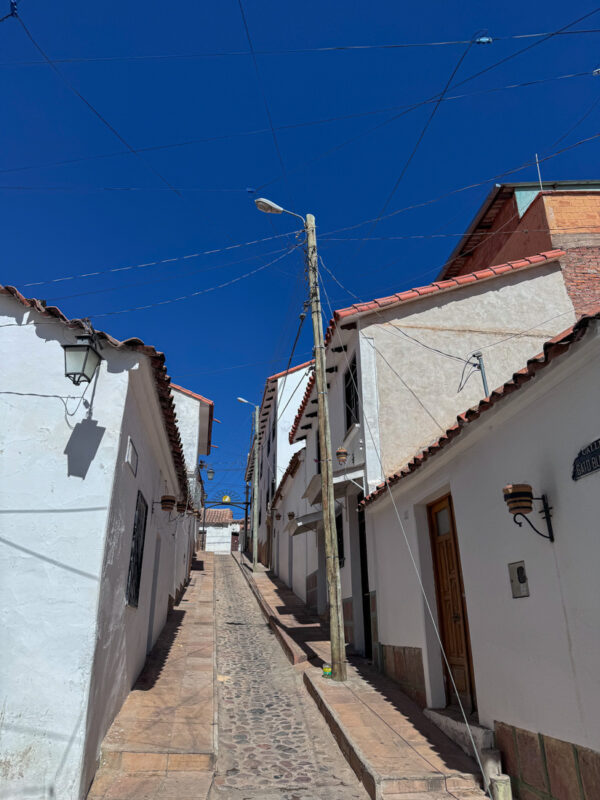

The best things to do in Sucre
I’ve already covered most of this in the above points, but for those in a rush, here’s a quick summary of the best things to do in Sucre:
- Visit Cal Orck’o to see dinosaur footprints
- Join a walking tour to learn more about the city’s past
- Visit one of the many museums
- Visit El Mercado Central for some local food
- Try a fine-dining tasting menu
- Hike to one of the many viewpoints (Mirador La Recoleta is my favourite)
- Watch the world go by in Plaza 25 de Mayo
Summary: Is Sucre worth visiting?
If my reasons you should visit Sucre haven’t convinced you already, I’m here to say that the city is ABSOLUTELY worth visiting. It’s one of those places where you could have a busy couple of days seeing lots, or spend weeks basing yourself there to get a real feel for local life in Bolivia.
Even if you just pass through for the day, Sucre is a fascinating spot in Bolivia.
Thanks for reading!


